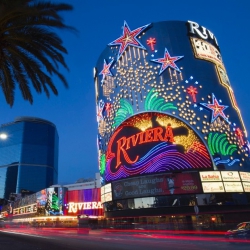A controlled implosion brought down one of the towers at the Riviera Hotel & Casino on the Las Vegas Strip this morning. The implosion was planned by the Las Vegas Convention and Visitors Authority, which bought the Riviera last year as part of its plan to expand the convention center.
The implosion of the Riviera cost the convention authority $42 million. Its destruction was planned for 2:30 am, so there would be less traffic in the area. The Monte Carlo Tower is expected to be imploded in August of this year. The rubble from the tower demolished this morning must be removed before the second tower can be destroyed.
History of the Riviera
The Riviera was built on the Las Vegas Strip in 1955, in the Golden Age of Las Vegas. In many ways, the hotel-casino helped usher in the golden age, because it was the first high rise on the Strip.
Many see the demolition of the landmark as the end of an era. The Riviera was built by “family men of Chicago” — meaning, in the parlance of the time, Chicago mobsters. The casino’s concert venue played host to the biggest entertainers in the United States over the decades: Frank Sinatra, Liberace, and Barbara Streisand.
Casinos in the 40s and 50s
The casinos opened in the 1940s and 1950s were either owned by the American mafia or had their money services controlled by them. The mobsters could skim from the profits and send the proceeds back to their home cities in the east, to bankroll their illegal racketeering operations in various niches: drugs, gambling, prostitution, protection rackets, and assassination. Casinos like the Riviera, the Sands, the Dunes, the Stardust, and the Desert Inn were operated by the mob.
Geoff Schumacher, a historian for the National Museum of Organized Crime and Law Enforcement (or “Mob Museum”), said the Riviera was a bit of an urban legend in the area. Schumacher said, “Ironically, the Riviera is as famous for its imaginary self as much as its actual self.”
Only The Flamingo and Tropicana Remain
With the Riviera gone, the rebuilt Flamingo and the original Tropicana are the only remaining casinos from the Fifties. According to Geoff Schumacher, the Riviera held a special place. He added, “The Riviera was and always was the Chicago outfit’s crown jewel in the desert.”
Over the decades, the Las Vegas Strip has undergone a constant updating and reinvention. When Bugsy Segal built the Flamingo in the 1930s and 1940s, it would have taken a visionary to imagine what Las Vegas has become. The city was within a car’s ride or short flight from Los Angeles, the recently-built Hoover Dam provided a ready water supply, and gambling was legal. Otherwise, little recommended the idea that the desert-bound Las Vegas would become a gaming destination.
In the late-1940s and 1950s, America’s middle class experienced a newfound wealth and prosperity never before seen in human history. Many Americans had more disposable income to spend, more work-related stresses in the modern business world, and better modes of transport. Those Americans wanted vacation getaways and Las Vegas provided the glitz, excitement, and entertainment that did not exist near their hometowns. With the Elvis Presley, the Rat Pack, and other luminaries performing on the Vegas Strip, Sin City was the place to be in the middle decades of the 20th Century.
By the 1980s, Las Vegas seemed a little staid. It had a reputation as a gaudy, mob-controlled destination for the nouveau riche which seemed to limit its growth potential. Then the new wave of construction began, ushered in by Steve Wynn’s work on the Mirage and Treasure Island in 1989 and later in the 1990s. This brought the corporatization of Las Vegas, when the city had more shows like Cirque du Soleil and David Copperfield, and a vacation seemed a bit more family friendly.
With the big casino resorts dominating the scene, older casino-hotels like the Riviera seemed quaint, but outmoded. Thus, the demolition of the Riviera is further sign that an era has passed.
Riviera’s Media Appearances
Even those who never visited Las Vegas might recognize the Riviera. The casino was pictured in the movie Casino, starring Robert DeNiro, Joe Pesci, and Sharon Stone.
The Monte Carlo is a 2,075-room property bought by the Las Vegas Convention and Visitors Authority for $182.5 million last year, plus $8.5 million in assorted other fees. The Monte Carlo stretches over a 26-acre area, which should give the new convention center a large area for expansion in the center of the city.

